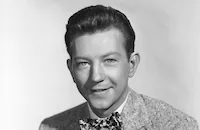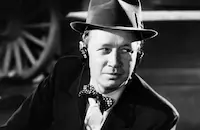Private Buckaroo

Brief Synopsis
Cast & Crew
Edward F. Cline
The Andrews Sisters
Dick Foran
Joe E. Lewis
Jennifer Holt
Shemp Howard
Film Details
Technical Specs

Synopsis
As Harry James and His Music Makers serenade a nightclub audience to the tune of "You Made Me Love You," Sergeant "Muggsy" Shavel arrives with his fiancée, Bonnie-Belle Schlopkiss. Although Muggsy pleads with Bonnie-Belle to go "to the park" instead, especially after he ascertains the high prices of the establishment, she insists on staying. Backstage, Harry learns that he has been drafted, much to the chagrin of singer Lon Prentice, who has been rejected by the U.S. Army for his "flat foot." After bribing the headwaiter, Muggsy and Bonnie-Belle finally get a table, but it is next to the kitchen. Undaunted, the couple moves their table to the front of the dance floor, where Bonnie-Belle immediately attracts the attention of nightclub performer Lancelot Pringle "Biff" McBiff. While Muggsy is infuriated by Biff's brazen advances, Bonnie-Belle welcomes them, particularly when she learns that Muggsy hasn't the money to pay for dinner. Later, Lon sees a foot specialist, who corrects his "flat foot," and he joins Harry at the induction center as a volunteer draftee. The entire band also enlists, and they are soon in training at Camp Healy. There Lon is nothing but a problem, as he doesn't feel he needs any "special training" to join the Army, much to the frustration of his sergeant, Muggsy. The new recruit goes to the captain, who decides to let Lon skip any "unnecessary" training in hopes that he will come around on his own. Meanwhile, Biff and the Andrews Sisters have joined the U.S.O., and they come to Camp Healy to entertain the new soldiers. At the dance that night, Tagalong Mason agrees to introduce Lon to her beautiful older sister Joyce, but he is upset to learn that she is the same woman with whom he had fought earlier. Still, Lon is taken with her until he learns that her uncle is Colonel Elias Weatherford, the commander of the base amd later finds her kissing a man, unaware that he is her brother, Lieutenant Howard Mason. In the meantime, the romantic rivalry between Muggsy and Biff over Bonnie-Belle heats up so much that the young woman ends up striking her one-time fiancé with a flower pot. Lon soon becomes the most unpopular man in the camp, and only as his platoon is about to ship out does he realize his mistake. He goes to Colonel Weatherford and asks to stay with his platoon, but the officer tells him that he must learn "respect" before he can become a good soldier. Lon then condenses weeks of training into a few days. Just before the troops ship out, the U.S.O. puts on a big show, featuring Lon, Biff, Harry and the Andrews Sisters. As the soldiers prepare to leave, Joyce confesses her love to Lon, and gives him a bracelet bearing the inscription, "Hands Off. This Guy Belongs to Me. Joyce." The soldier then leaves to join his comrades in the war, as the Andrews Sisters sing "We've Got a Job to Do."

Director
Edward F. Cline
Cast

The Andrews Sisters

Dick Foran
Joe E. Lewis
Jennifer Holt

Shemp Howard
Richard Davies

Mary Wickes

Ernest Truex

Donald O'connor

Peggy Ryan

Huntz Hall
Susan Levine
The Jivin' Jacks And Jills
Harry James

Addison Richards
Robert Emmett Keane

Eddie Acuff
Pat Flaherty
Grace Hayle
George Chandler
Wade Boteler
Ed Stanley
Edmund Glover
Billy Wayne
Eddie Bruce
Sidney Miller
Gene O'donnell
Eddie Parker
Joey Ray
Crew
Robert Boyle
Woody Bredell
Bernard B. Brown
Lew Brown
Jerry Cady
Milton Carruth
Ted Deputy
Lloyd French
Sammy Gallop
R. A. Gausman
Ken Goldsmith
Edward James
Harry James
Harry James
Art Kassel
Edmund Kelso
Vic Knight
Lester Lee
Norman Litman
John Jacob Loeb
Carmen Lombardo
Jack Matthias
Jack Matthias
John Mattison
Joseph Mccarthy
Joseph A. Mcdonough
Vic Mizzy
James V. Monaco
Paul Neal
Charles Newman
Jack Otterson
Gene De Paul
Alberto Pestalozza
Don Raye
Dalton Rizzotto
Sid Robin
Vic Schoen
Milton Searls
Jerry Seelen
Dan Shapiro
Paul Gerard Smith
Sammy Stept
Irving Taylor
Charlie Tobias
Vera West
Allie Wrubel

Film Details
Technical Specs

Articles
Private Buckaroo
The diversion is provided by some of the best and most popular musical acts of the day. Trumpeter Harry James plays a fictionalized version of himself, drafted into the Army along with his lead singer, Lon Prentice, played by singing cowboy Dick Foran as a vain and arrogant recruit who must be taken down a few pegs and taught to be a team player, a pretty standard trope for war movies but here played mostly for fun.
Also on hand are a teenage Donald O'Connor and his on-screen partner at the time, Peggy Ryan (Universal Pictures' answer to Mickey Rooney and Judy Garland), nightclub comedian Joe E. Lewis and on-and-off Three Stooges actor Shemp Howard, brother of Moe and Curly, whose scenes with the inimitable Mary Wickes are some of the funniest in the picture.
Other than James, the biggest pop stars to appear (also as themselves) are the singing Andrews Sisters, then at the height of their popularity thanks to such huge hits as "Bei Mir Bist Du Schön," "Don't Sit Under the Apple Tree (With Anyone Else but Me)," "Rum and Coca-Cola" and the song most associated with them and their wartime popularity (although released nearly a year before the U.S. entered World War II), "Boogie Woogie Bugle Boy." One would expect them to perform that number in this picture, but it had already debuted in another Universal production, the Abbott and Costello comedy Buck Privates (1941), well over a year earlier. They did, however, get to sing "Don't Sit Under the Apple Tree" in this film.
Unlike his onscreen depiction in Private Buckaroo, a back injury kept the real-life James out of the service. His band - second in popularity only to Glenn Miller's during this time - never included Foran but featured several lead vocalists, including Frank Sinatra, Dick Haymes and Helen Forrest, who gets to perform one of their biggest hits, "You Made Me Love You," in this film.
The director is Edward Cline, best known for co-directing a number of Buster Keaton films in the silent era, including such classic shorts as One Week (1920), The Scarecrow (1920) and The Balloonatic (1923) and the feature Three Ages (1923). Even as Keaton's career tanked, Cline continued to work, directing W.C. Fields in some of his biggest comedies, The Bank Dick (1940), My Little Chickadee (1940) and Never Give a Sucker an Even Break (1941). He and Keaton were reunited for two television series in the early 1950s, The Buster Keaton Show and Life with Buster Keaton.
Private Buckaroo is a public domain film, meaning no individual or company owns the rights to it anymore. A number of films, including such classics as Keaton's The General (1926), Howard Hawks' comedy His Girl Friday (1940) and the cult film noir Detour (1945), failed for various reasons to have their copyrights renewed within the 28-year time frame then allotted. In 1966, Congress passed an extension of the copyright to 75 years, but those that fell into public domain prior to that remained. Although some films fall into this category, some of their aspects, such as the songs in this picture, are still protected.
Director: Edward F. Cline
Producer: Ken Goldsmith
Screenplay: Edmund Kelso, Edward James, from an original story by Paul Gerard Smith
Cinematography: Elwood Bredell
Editing: Milton Carruth
Art Direction: Jack Otterson
Cast: The Andrews Sisters (Themselves), Harry James (Himself), Dick Foran (Lon Prentice), Joe E. Lewis (Lancelot Pringle McBiff), Ernest Truex (Col. Elias Weatherford)
By Rob Nixon

Private Buckaroo
Peggy Ryan (1924-2004)
Born Margaret O'Rene Ryan on August 28, 1924, in Long Beach, California, Ryan began dancing professionally as a toddler in her parents' vaudeville act, the Dancing Ryans, and was discovered by George Murphy when she was 12. Murphy arranged for young Peggy to dance with him in the Universal musical Top of the Town (1937). She would go on to make a few more film appearances over the next few years - the most striking of which as a starving, homeless girl in John Ford's The Grapes of Wrath (1940) - yet for the most part, she was hardly noticeable apart from a few dance numbers.
Her luck changed when Universal cast her opposite another teenage hoofer, Donald O'Connor in What's Cookin'? (1942). From then on, they teamed in a series of innocuous musicals that were low on production values, but high on youthful pluck. Just check out some of their titles: Private Buckaroo, Give Out, Sisters!, Get Hep to Love (all 1942); Top Man, Mr. Big (both 1943); Chip Off the Old Block, This Is the Life, and Bowery to Broadway (all 1944). They may have not been high art, but jitterbuggin' kids loved it, and given the low investment Universal put into these pictures, they turned quite the profit.
Her career slowed down after the war. In 1945, she married songwriter James Cross, and didn't return to films until 1949, when she made two minor musicals that year: Shamrock Hill, There's a Girl in My Heart. She divorced Cross in 1952 and met her second husband, dancer Ray McDonald, in her final film appearance, a forgettable musical with Mickey Rooney, All Ashore (1953). Tragically, McDonald died in 1957 after a food choking incident, and the following year, Ryan moved to Honolulu after marrying her third husband, Honolulu Advertiser columnist Eddie Sherman. She kept herself busy teaching dance classes at the University of Hawaii, but in 1969, she found herself back in front of the camera as Jenny Sherman, secretary to Detective Steve McGarrett (Jack Lord) on the long-running show Hawaii Five-O,. She played the role for seven years, remaining until 1976.
Eventually, Ryan relocated with her husband to Las Vegas, where for the last few years, she was teaching tap dancing to a whole new generation of hoofers. She is survived by her son, Shawn; daughter Kerry; and five grandchildren.
by Michael T. Toole
Peggy Ryan (1924-2004)
Quotes
Trivia
Notes
According to Universal publicity materials, actress Jennifer Holt, the daughter of actor Jack Holt, made her screen debut in this picture. The songs "Don't Sit Under the Apple Tree" and "Johnny Get Your Gun Again" were significant hits for the Andrews Sisters. Press materials also claim that Harry James's trumpet, which was custom-made for the musician, was insured by the studio for $2,500 during the making of this film and that it had its own guard, ex-Los Angeles City policeman Milton Searls. Hollywood Reporter production charts include Joan Davis in the cast, but she did not appear in the released film. A Hollywood Reporter news item includes Bobby Scheerer in the cast, but his participation in the released film has not been determined. Universal press materials also include the following as members of Harry James' Music Makers at the time of this film: Claude Bowen, Dominick Buona, Alexander Cuozzo, Dalton Rizzotto, Hoyt Bohanon, Harry Rogers, Claude La Key, George Davis, Sam Marowitz, Gene Corcoran, Leo Zorn, Samuel Caplan, John Peter DeVoogdt, William Spear, Elias Friede, Albert Lerner, Thurman Payne Teague, Ben Heller and Mickey Scrima, along with vocalists Helen Forrest and Jimmy Saunders. It has not been determined, however, which of these musicians actually appear in the released film.














